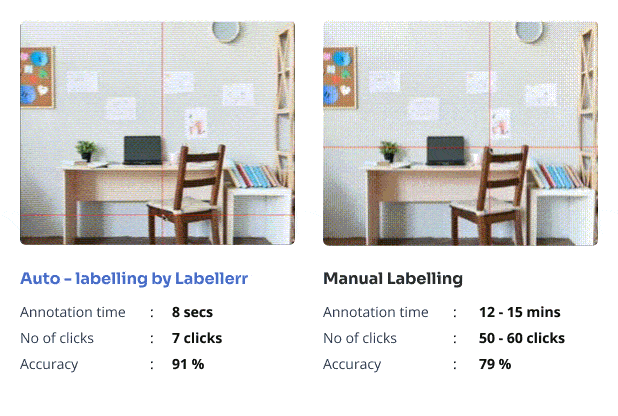Generate Super Fast Annotations For Virtual Surveys Model Using SAM

Table of Contents
- Introduction
- Challenge
- Solution: Labellerr’s Role in Virtual Surveys
- Conclusion
- Frequently Asked Questions
Introduction
In the world of the home services industry, efficiency and precision are important.
Property inspections are essential for moving and home insurance companies, traditionally demanding significant resources, primarily in the form of physical visits to customer homes for estimations and measurements.
Imagine you're part of a home insurance or moving company tasked with inspecting properties for estimates and measurements.
Picture the amount of resources required for each visit the time, the manpower, and the logistical challenges of coordinating these appointments.
However, with the advancements in AI technologies, the industry is experiencing a transformative shift towards more streamlined and cost-effective solutions.
One such innovation is the utilization of AI-powered virtual surveys to revolutionize property inspections.
Challenge
Despite the benefits of AI-powered virtual surveys, there are many challenges along the way.
Length of Dataset: One significant problem faced by companies is the task of annotating a large dataset of lengthy videos and images with masks for segmentation models. Imagine the task of annotating a vast dataset of lengthy videos with complex masks for segmentation models.
Traditional methods of annotation, such as bounding box annotation, often fall short when dealing with complex data.
Annotators can use active learning methods to determine which areas of the dataset need human annotation. The model can recognize ambiguous or difficult parts, allowing annotators to focus their efforts on the parts that require the most improvement.
Intricate 3D Environments: Virtual surveys may incorporate highly detailed 3D environments. To successfully navigate the virtual realm and appropriately describe things or interactions, annotations may necessitate specialized skills or tools.
Annotators may try crowd-sourcing activities such as object labeling or basic annotations in a 3D environment. This allows for the distribution of effort and the use of a larger team's shared intelligence.
Data Ambiguity: It's possible for virtual surveys to incorporate scenarios or interactions that are not entirely clear, necessitating interpretation. Using virtual avatars or body language to annotate user intent or emotional responses could be difficult and necessitate specific standards.
Limited Datasets: The area of virtual survey models may still be in its early phases, which means there aren't a ton of publicly available datasets to annotate. The ability to create and refine AI models for evaluating data from online surveys may be hindered by this.
Annotators should develop methods for creating synthetic virtual survey data with a variety of environments and user interactions. This can provide more data to the real-world datasets and increase model generalizability.
The large volume and complexity of the data require a simpler approach for annotation, which would surpass the capabilities of in-house tools typically used for such tasks.
Organizations need precise segmentation annotations within lengthy datasets, which is presented as a challenge that their current tool cannot address.
Solution: Labellerr’s role in Virtual Surveys

Labellerr's advanced capabilities address the challenges faced by companies seeking to transition to AI-driven virtual surveys seamlessly.
Read the full documentation for using SAM in an annotation workflow with Labellerr.
By using cutting-edge AI algorithms, Labellerr enables the precise annotation of lengthy videos with complex masks, surpassing the limitations of traditional annotation methods.
Watch the video below to see how Labellerr and SAM streamline the annotation process for virtual surveys:
With Labellerr as their trusted partner, they can embark on a journey of innovation, transforming the way property inspections are conducted.
Below we discuss multiple factors by which Labellerr helps teams to overcome challenges.
1. Intuitive Interface
Labellerr provides an intuitive user interface, ensuring ease of use for annotators.
Annotators can easily access the necessary tools and features, allowing them to focus on the task at hand without being hindered by complex interfaces.
Users can efficiently annotate datasets, saving valuable time and resources in the process.
2. Robust Segmentation Features
Labellerr has robust segmentation features that enable annotators to identify and segment key elements within videos with high accuracy.
Labellerr's advanced segmentation capabilities are powered by the Segment Anything Model (SAM), an algorithm designed to annotate a wide array of objects and structures within images.
SAM excels at accurately outlining various elements, ranging from simple shapes to complex objects, with precision and efficiency. By leveraging SAM, Labellerr enables users to annotate images with high accuracy.
SAM's flexibility and accuracy make it an indispensable tool for a wide range of annotation tasks.
These features are important for property inspections, where precise segmentation is crucial for tasks such as measuring dimensions and analyzing structural components.
3. Scalability
One of Labellerr's key strengths is its scalability, allowing companies to handle datasets of any size with ease.
Whether it's a small-scale project or a large-scale deployment, Labellerr can accommodate the needs of businesses in the home services industry.
The platform's scalability ensures consistent quality and efficiency, regardless of the size or complexity of the dataset.
4. Custom Workflows:
Labellerr offers customizable workflows tailored to the unique needs and requirements of each project.
Companies in the home services industry can create custom annotation pipelines that align with their specific objectives and workflows.
Whether it's defining annotation tasks, setting up review processes, or integrating with existing tools and systems, Labellerr provides the flexibility to adapt to various project workflows seamlessly.
5. Active Learning Based Labeling
Labellerr incorporates active learning techniques to optimize the annotation process and improve model performance over time.
Through active learning, Labellerr intelligently selects the most informative data points for annotation, focusing on areas where the model is uncertain or likely to benefit from additional training data.
By leveraging active learning, companies can reduce annotation costs, and enhance the overall performance of AI models deployed in property inspections.
6. Automated QA (Quality Assurance)
Labellerr incorporates automated quality assurance (QA) mechanisms to ensure the accuracy and consistency of annotated data.
Using Labeller users can flag potential errors or inconsistencies in annotations, allowing annotators to review and correct them efficiently.
7. Automated Import and Export of Data
Labellerr streamlines the data management process with automated import and export functionalities.
Companies can easily import large volumes of video data into the platform for annotation, eliminating the need for manual data entry and tedious file uploads.
Labellerr allows seamless export of annotated data in various formats, making it easy to integrate with other processes and AI pipelines.
8. Collaborative Annotation Pipeline
Labellerr promotes collaboration by allowing multiple users with different roles to contribute to the annotation process.
This collaborative approach ensures diverse perspectives and expertise are considered while annotating, leading to a more comprehensive and accurate understanding of the objects involved.
Conclusion
In conclusion, Labellerr's impact on the home services industry lies in its ability to revolutionize the annotation process for datasets crucial to property inspections.
Through its advanced annotation tools, intuitive interfaces, and robust segmentation features.
Labellerr streamlines the annotation of home services industry datasets with high efficiency and accuracy.
Frequently Asked Questions
Q1) What is the home services industry, and how do virtual surveys impact it?
The Home Services Industry encompasses various services related to residential properties, including moving, home insurance, maintenance, and renovations.
Virtual surveys leverage AI technology to conduct property inspections remotely, reducing the need for physical visits and streamlining processes.
Q2) How does Labellerr facilitate the annotation of datasets for virtual surveys in the home services industry?
Labellerr offers advanced annotation tools specifically for the complexities of property inspections.
Its intuitive interface, robust segmentation features, and customizable workflows enable efficient and accurate annotation of datasets crucial for virtual surveys.
Q3) Can Labellerr handle large-scale annotation projects in the home services industry?
Yes, Labellerr is highly scalable and can accommodate datasets of any size, from small-scale projects to large-scale deployments. Its automated import/export functionalities further streamline the annotation workflow, ensuring efficiency and reliability.

Simplify Your Data Annotation Workflow With Proven Strategies
.png)


